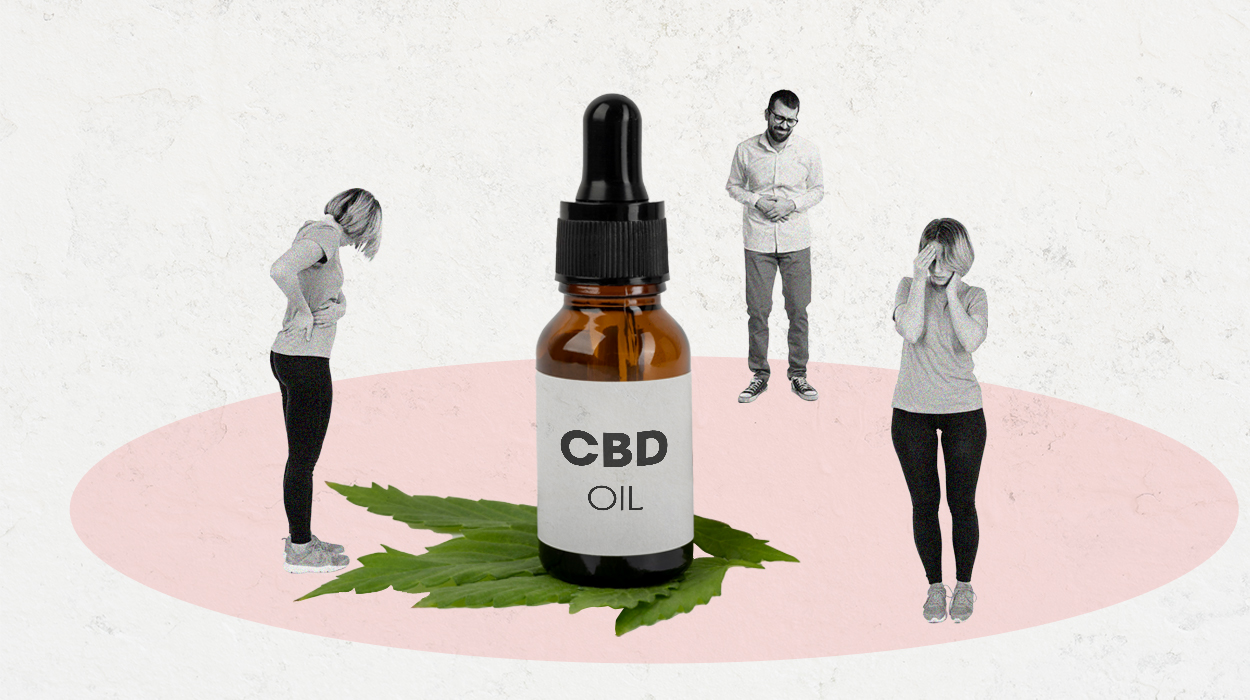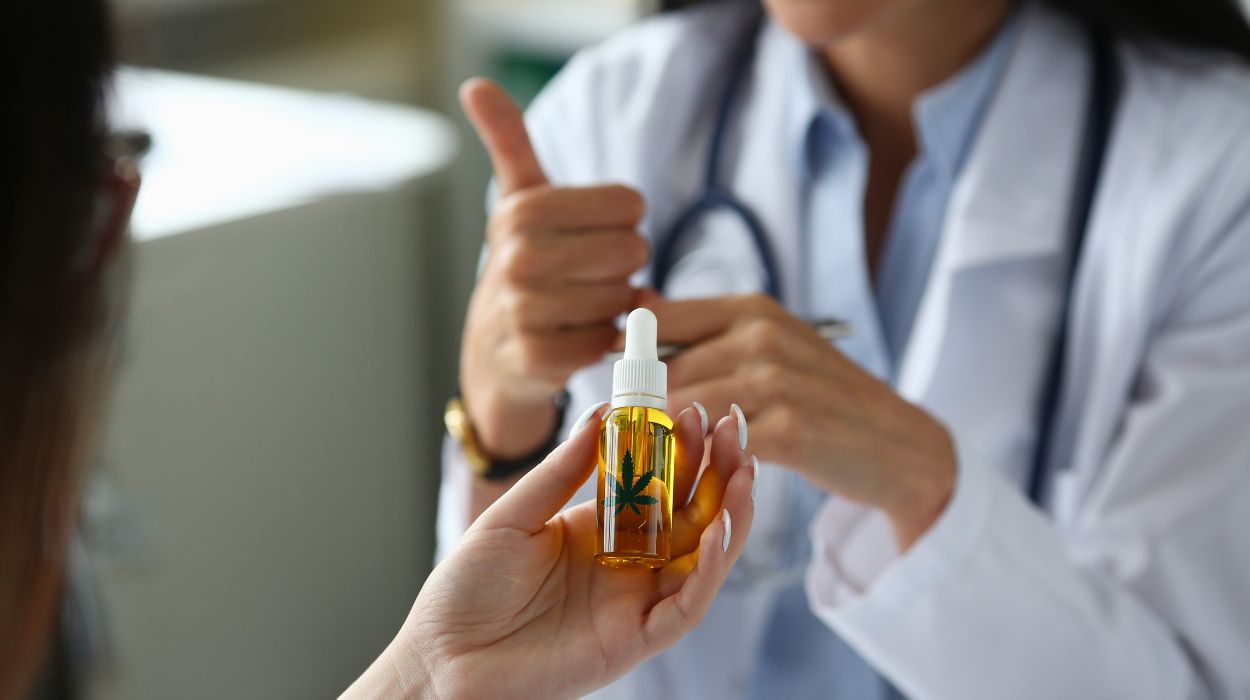 Expert's opinion
Expert's opinion
Expert's opinion
The article is a subjective view on this topic written by writers specializing in medical writing.
It may reflect on a personal journey surrounding struggles with an illness or medical condition, involve product comparisons, diet considerations, or other health-related opinions.
Although the view is entirely that of the writer, it is based on academic experiences and scientific research they have conducted; it is fact-checked by a team of degreed medical experts, and validated by sources attached to the article.
The numbers in parenthesis (1,2,3) will take you to clickable links to related scientific papers.
CBD For Pain 2024 – An Opioid Alternative?

During the late 1990s, pharmaceutical corporations reassured the medical community that patients wouldn’t become obsessed with prescription opioids for pain management, and healthcare suppliers began to prescribe them at higher rates. This afterward led to widespread diversion and misuse of these medications before it became clear that these medications may indeed be extremely addictive.
Worst results of the opioid epidemic cover increases in opioid misuse and related overdoses, also as the increased incidence of newborns having withdrawal syndrome due to opioid use and misuse during pregnancy. Opioid overdoses are involved in over 42,000 deaths during 2016, more than any preceding year on record. It was known that 40% of opioid dose deaths result from the prescription of opioids
Counteract and access to treatment for opioid addiction and overdose reversal medicine are crucial to fighting this epidemic. Primary care setup has progressively become an opening to higher care for people with both behavioral health (as well as substance use) and primary care needs.
CBD Vs Opioids For Chronic Pain Management
The research,[1] written in the Journal of Psychoactive Drugs, which checked out 1,000 individuals using medical marijuana in the USA found that between 65% of individuals consuming or using cannabis to manage pain, 80% found it was very or exceptionally effective.
74% of the 1,000 interviewees bought it to assist them to sleep, and 84% think CBD may replace opioids. inline with those supporting CBD oils as an alternative to opioids, the two biggest benefits of CBD compared to opioids are:
- CBD has fewer/less dangerous side effects
- CBD frees the addiction and/or overdose
The research[2] suggests that cannabis may lower opioid use. However, the researchers caution that a lot more has to be done to know the potential therapeutic advantages of cannabis. It additionally adds importance to the idea that widening access to CBD may lower the use of prescription painkillers, allowing more individuals to handle and cure their pain without counting on opioid prescription medicines that have dangerous side effects.
What Is The Opioid Pain Relievers Crisis?
Opioids used for pain management are safe once taken for a brief time and as prescribed by a doctor, but since they end up in high spirits to boot to pain relief, they’ll be abused (taken throughout a unique means or taken while not a doctor’s prescription). Regular use, once prescribed by a doctor, can lead to independence, and once abused, opioid pain relief could result in serious side effects, addiction, drug incidents, and deaths.
Enhancements are discovered in many regions of the country at intervals the kind of reducing the provision of prescription opioid pain relievers and declining misuse together with however since 2007, overdose deaths connected to diacetylmorphine are increasing. Serious consequences of the opioid pandemic embrace a rise in opioid abuse and associated overdose, further because of the rising incidence of newborns experiencing withdrawal syndrome because of opioid use and misuse during pregnancy.
The Cost Of Pain, Study Shows
Based on the research information, the authors determined that the entire cost of pain within the US ranged from $560 to $635 billion. Total progressive prices of health care because of pain ranged from $261 to $300 billion, and also the price of lost productivity ranged from $299 to $334 billion. Compared with different major sickness conditions, the per-person value of pain is lower but the overall price is higher.
Furthermore, adults with pain announced missing more days from work than individuals with no pain. Pain negatively affected three parts of productivity: workdays missed, the number of annual hours worked, and hourly wages.
American’s Use Of CBD Products
Who usually uses hemp-derived CBD products in their daily lives? You may think that many people use it more than you may expect. However, experts found that 14% of American citizens use CBD products, While a common fraction of our respondents stated that they presently use or have used CBD products.
Amazingly, among the individuals who have using CBD products, 35 to 44-year-olds are the group possibly to continue using them, while younger individuals usually use them for a short amount of your time, then stop. These numbers taper off in older populations. Almost 70% of respondents aged 55 to 64 and 80% of respondents aged 65 and older the same that they need never use CBD products. CBD from the hemp plant is considered legal because it has zero to 0.3 percent THC levels. CBD and THC are different from each other, THC makes a person “high”.
What Types Of Pain Can Cannabidiol (CBD) Treat?
Chronic neuropathic pain is created and sustained because of the glutaminergic system, which could be a major excitatory neuronal pathway. Glutamate is the neurotransmitter that’s accountable for turning neurons on, which is better, sometimes.
Pain needed anti-inflammatory has something to do with neuropathic pain, except it’s not restricted to neurons. Examples of inflammatory pain cover all kinds of arthritis pain, a couple of autoimmune diseases like Crohn’s and ulcerative colitis, and common conditions like headaches, cramps, muscle aches, and pains.
The research has been positive on CBD drugs and pain relief. In order to control their symptoms, some people with chronic pain use CBD oils, particularly CBD topicals. Various kinds of pain can be minimized by CBD oil. It is also used as an anti-inflammatory agent that is associated with inflammation as well as pain.
For individuals that have chronic pain and depend on drugs, such as opioids, CBD may provide an option that can be a daily ritual.
CBD For IBS (Irritable Bowel Syndrome)
The IBS (Irritable Bowel Syndrome) medical condition which greatly affects your digestive system and causes abdominal pain and altered bowel habits. It may happen to anyone regardless of their age and gender.
Cannabis is believed to act within the gastrointestinal tract through tetrahydrocannabinol (CBD and THC), which connects to G-protein coupled cannabinoid receptors, CB1, and CB2. These modify gut motility and colonic tone by lowering the presynaptic release of excitatory neurotransmitters, primarily acetylcholine, and substance P, from myenteric neurons.
Many studies[3] have evaluated the results of dronabinol, an artificial THC oral agent, on intestinal motility and compliance, and visceral perception in IBS patients and healthy volunteers.
Scientists are still unraveling the complexities of irritable bowel syndrome, and personalized medical advice could take years to come. Until then, trial and error through careful trial is the best we can all do.
Cancer Pain & Treatment-Related

In a study involving 21 patients suffering from chronic pain, we’re given vaporized CBD given with morphine pain relief better than morphine alone, While if it is consumed with oxycodone, it won’t much give changes but still more studies are needed.
Controlled cases of inhaled Cannabis in those with peripheral neuropathy or other nerve pain showed that the pain was reduced in patients who received inhaled Cannabis compared with those who received an ineffective pill.
Research on Cannabis extract [4] that was used by holding a few drops beneath the tongue found that CBD may help patients with advanced cancer whose pain wasn’t eased by robust opioids only. In another study, patients who received lower doses of cannabinoid spray showed higher pain relief and reduced insomnia than patients who received a placebo.
Management of cancer-related pain in several patients was higher without the requirement for higher doses of THC CBD extract spray or higher doses of their different pain medicines.
Another study [5] shows that delta-9 psychoactive drugs could relieve pain also as codeine. It shows that patients had sensible pain relief, less nausea-associated degree of vomiting, and better appetite.
For a wonderful comprehensive review of the endocannabinoid system[6], Walker and Huang have provided a key review of the antinociceptive effects of CBD in models of acute and protracted pain.
Nerve Pain & Neuropathy
When pathology involves injury to the motor nerves, quality of life is reduced during which some patients suffer muscle weakness, uncontrolled twitching, and painful cramps in line with the NINDS.
CBD has been valid as a medicine agent in many studies—it also has neuroprotective properties. Endocannabinoids flow within the blood and cause their effects by connecting our cannabinoid receptors. Currently, there are 2 well-researched cannabinoid receptors: CB1 and CB2. those that are necessary with respect to medicine are our CB1 receptors. These are found in nerve endings and additionally the brain and are connected to the origin of the pain sensation.
Experts from the analysis Institute of the McGill University hospice and McGill University in Quebec, Canada, state that, once conducting varied studies on animals, “low doses of CBD given for seven days to alleviate each pain and anxiety, these two symptoms typically connected in neuropathic pain or chronic pain.”
When overwhelming full-spectrum CBD oil for neuropathic pain, it’s best to consume it sublingually, which suggests applying it below your tongue and holding it for one or two seconds to let the body absorb it. This method works best as a result of its connection to bioavailability and the way your body is in a position or able to receive and victim CBD oil.
Migraines

Clinical publications between 1839 and 1937[7] give valuable insights into the most effective practices, challenges, and advantages during an era when cannabis was normally used to treat headaches.
After cannabis was considered illegal by the U.S. government, its therapeutic use and research into its medical edges were mostly interrupted. Currently, there are few clinical investigations of the utilization of cannabis for headaches; however, the studies that have emerged demonstrate potential effectiveness.
Furthermore, various pre-clinical investigations have verified the role of endocannabinoids in preventing headache pathophysiology, which implies a mechanistic role of cannabis within the treatment of these disorders.
Cannabis also shows the potential to interrupt specific stages within the pathogenesis of headaches, together with glutamate signaling resulting in CSD, cranial blood vessel dilation caused by NO and CGRP, serotonin unleashes from platelets and afferent trigeminovascular nociceptive inputs.
Chronic Back Pain
Although a less serious condition, it will cause plenty of discomfort and disturbance in the lives of individuals affected by back pain.
One report proves[8] that the momentary use of CBD oil may lessen the amount of spasticity an individual feels. The results are modest, but many individuals stated a relief of symptoms. More studies on humans are required to verify these results.
Many researchers[9] assume that CBD communicates with a core component of the endocannabinoid receptors in your brain and immune system. Receptors are tiny proteins connected to your cells. They receive signals, principally chemical ones, from utterly completely different stimuli and facilitate your cells’ response.
This response produces anti-inflammatory and pain relief results that help with managing pain. This implies that CBD oil and other products may benefit individuals suffering from chronic pain.
Fibromyalgia
Fibromyalgia is a kind of chronic pain disorder that makes musculoskeletal pain additionally to fatigue, insomnia, and cognitive problems. It mostly affects women, and presently, there’s no identified cure for the condition. However, treatment choices are possible that targets pain management.
CBD was normally used to relieve chronic pain symptoms and lessen inflammation. It’s presented as an alternative to using opioid medicines that might be addictive.
However, the FDA (Food and Drug Administration) didn’t yet approve CBD as a treatment for fibromyalgia or other different conditions. The CBD-based medication Epidiolex is the only CBD product that is FDA-approved and regulated.
There are presently no published studies on fibromyalgia that examine the results of CBD on its own. But some research[10] does verify the effects of CBD, which may contain multiple cannabinoids, on fibromyalgia.
How To Use CBD For Pain?
How To Determine Your CBD Dosage?
The quantity of CBD you must take depends on some factors, including:
- Your body weight
- The condition you’re treating
- Your body chemistry
- The concentration of CBD in each pill, capsule, and more
In alternative words, there are heaps of variables that get in deciding what proportion CBD to take.
We have a tendency to suggest that you simply begin with a low dosage and if that doesn’t work increase from there. The COR commonplace might be a product of an intensive analysis of various CBD products. You’re capable of accelerating the amount of CBD oil intake by 25mg every 4 weeks until you’re alleviated. However, if the symptoms worsen, cut back it by 25mg.
If you’re using CBD oil, it’ll most likely be available in a dropper bottle. The packaging might specify what amount of CBD is in a single drop. From there, you’ll conclude what range drops you want to use. In pain management, it’s suggested to use CBD Oil or topicals for easier use and quicker relief.
Before making an attempt at CBD, make certain to speak to your doctor regarding the proper indefinite quantity and any attainable problems. If your doctor tells you how abundant to use, follow their prescription.
How To Find The Right CBD For Your Pain Management Needs
CBD is simply one of more than a hundred cannabinoids found in hemp plants. As more analysis is poured into determining the most effective ways to use CBD oil for pain relief, companies are also providing different formulations within the market these days.
You need to know where the CBD needs to reach. If your target is anywhere near the skin, you can try a product like a topical first. This provides the highest CBD concentration exactly where you want it.
Otherwise, CBD needs to move through your bloodstream to reach its goal – whether it’s your brain, your immune system, or other locations. CBD oil, vaporizers, and oral products are best for this purpose.
To find the right CBD use for pain, be sure to check if pain CBD products are approved by FDA and provide third-party lab tests. It would also be better to consult your doctor regarding this matter.
Final Thoughts
There are differences between CBD and THC, but an additional concern with “medical marijuana” is that little is understood concerning the long-run impact of its use by individuals with health- and/or age-related vulnerabilities—such as older adults or individuals with cancer, AIDS, cardiovascular disease, multiple sclerosis, or different neurodegenerative diseases.
Further research will be needed to determine whether people whose health has been compromised by disease or its treatment are at greater risk for adverse health outcomes from marijuana u
+ 10 sources
Health Canal avoids using tertiary references. We have strict sourcing guidelines and rely on peer-reviewed studies, academic researches from medical associations and institutions. To ensure the accuracy of articles in Health Canal, you can read more about the editorial process here
- Journal of Psychoactive Drugs. (2019). Use of Cannabis to Relieve Pain and Promote Sleep by Customers at an Adult Use Dispensary. [online] Available at: https://www.tandfonline.com/doi/full/10.1080/02791072.2019.1626953.
- Bachhuber, M.A., Saloner, B., Cunningham, C.O. and Barry, C.L. (2014). Medical Cannabis Laws and Opioid Analgesic Overdose Mortality in the United States, 1999-2010. JAMA Internal Medicine, [online] 174(10), p.1668. doi:https://doi.org/10.1001/jamainternmed.2014.4005.
- Desai, P., Mbachi, C., Vohra, I., Salazar, M., Mathew, M., Randhawa, T., Haque, Z., Wang, Y., Attar, B. and Paintsil, I. (2020). Association Between Cannabis Use and Healthcare Utilization in Patients With Irritable Bowel Syndrome: A Retrospective Cohort Study. Cureus. [online] doi:https://doi.org/10.7759/cureus.8008.
- National Cancer Institute. (2022). Cannabis and Cannabinoids (PDQ®)–Patient Version. [online] Available at: https://www.cancer.gov/about-cancer/treatment/cam/patient/cannabis-pdq.
- Campbell, F.A. (2001). Are cannabinoids an effective and safe treatment option in the management of pain? A qualitative systematic review. BMJ, [online] 323(7303), pp.13–13. doi:https://doi.org/10.1136/bmj.323.7303.13.
- Walker, J.Michael. and Huang, S.M. (2002). Cannabinoid analgesia. Pharmacology & Therapeutics, [online] 95(2), pp.127–135. doi:https://doi.org/10.1016/s0163-7258(02)00252-8.
- Lochte, B.C., Beletsky, A., Samuel, N.K. and Grant, I. (2017). The Use of Cannabis for Headache Disorders. Cannabis and Cannabinoid Research, [online] 2(1), pp.61–71. doi:https://doi.org/10.1089/can.2016.0033.
- Rudroff, T. and Sosnoff, J. (2018). Cannabidiol to Improve Mobility in People with Multiple Sclerosis. Frontiers in Neurology, [online] 9. doi:https://doi.org/10.3389/fneur.2018.00183.
- Zou, S. and Kumar, U. (2018). Cannabinoid Receptors and the Endocannabinoid System: Signaling and Function in the Central Nervous System. International Journal of Molecular Sciences, [online] 19(3), p.833. doi:https://doi.org/10.3390/ijms19030833.
- Russo EB (2014). Clinical endocannabinoid deficiency (CECD): can this concept explain therapeutic benefits of cannabis in migraine, fibromyalgia, irritable bowel syndrome and other treatment-resistant conditions? Neuro endocrinology letters, [online] 29(2). Available at: https://pubmed.ncbi.nlm.nih.gov/18404144/.



